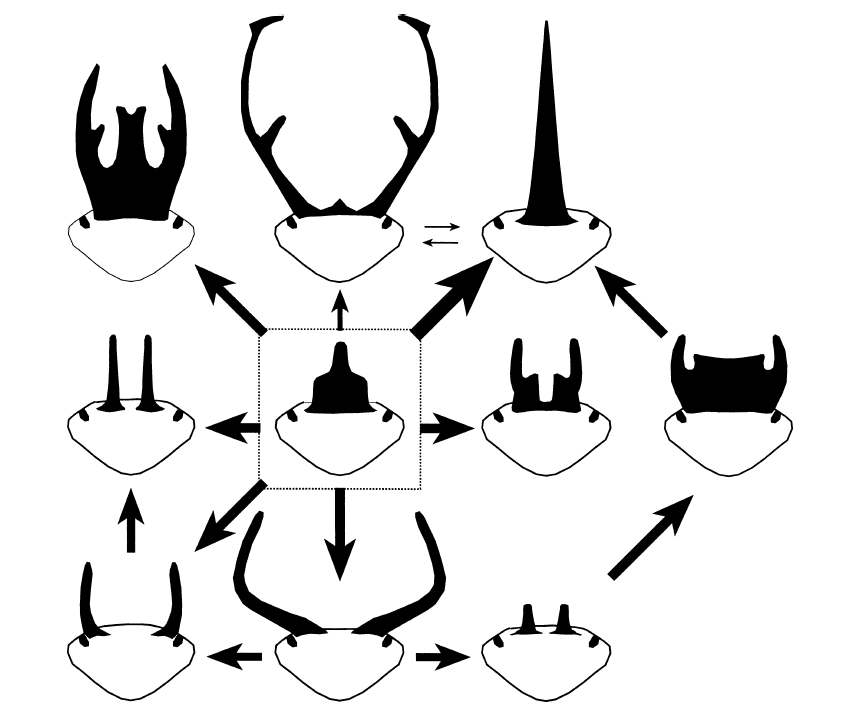URGENT – WEATHER MESSAGE
NATIONAL WEATHER SERVICE NEW ORLEANS LA
1011 AM CDT SUN AUG 28 2005..DEVASTATING DAMAGE EXPECTED
HURRICANE KATRINA
A MOST POWERFUL HURRICANE WITH UNPRECEDENTED
STRENGTH…RIVALING THE INTENSITY OF HURRICANE CAMILLE OF 1969.MOST OF THE AREA WILL BE UNINHABITABLE FOR WEEKS…PERHAPS LONGER. AT
LEAST ONE HALF OF WELL CONSTRUCTED HOMES WILL HAVE ROOF AND WALL
FAILURE. ALL GABLED ROOFS WILL FAIL…LEAVING THOSE HOMES SEVERELY
DAMAGED OR DESTROYED.THE MAJORITY OF INDUSTRIAL BUILDINGS WILL BECOME NON FUNCTIONAL.
PARTIAL TO COMPLETE WALL AND ROOF FAILURE IS EXPECTED. ALL WOOD
FRAMED LOW RISING APARTMENT BUILDINGS WILL BE DESTROYED. CONCRETE
BLOCK LOW RISE APARTMENTS WILL SUSTAIN MAJOR DAMAGE…INCLUDING SOME
WALL AND ROOF FAILURE.HIGH RISE OFFICE AND APARTMENT BUILDINGS WILL SWAY DANGEROUSLY…A
FEW TO THE POINT OF TOTAL COLLAPSE. ALL WINDOWS WILL BLOW OUT.AIRBORNE DEBRIS WILL BE WIDESPREAD…AND MAY INCLUDE HEAVY ITEMS SUCH
AS HOUSEHOLD APPLIANCES AND EVEN LIGHT VEHICLES. SPORT UTILITY
VEHICLES AND LIGHT TRUCKS WILL BE MOVED. THE BLOWN DEBRIS WILL CREATE
ADDITIONAL DESTRUCTION. PERSONS…PETS…AND LIVESTOCK EXPOSED TO THE
WINDS WILL FACE CERTAIN DEATH IF STRUCK.POWER OUTAGES WILL LAST FOR WEEKS…AS MOST POWER POLES WILL BE DOWN
AND TRANSFORMERS DESTROYED. WATER SHORTAGES WILL MAKE HUMAN SUFFERING
INCREDIBLE BY MODERN STANDARDS.THE VAST MAJORITY OF NATIVE TREES WILL BE SNAPPED OR UPROOTED. ONLY
THE HEARTIEST WILL REMAIN STANDING…BUT BE TOTALLY DEFOLIATED. FEW
CROPS WILL REMAIN. LIVESTOCK LEFT EXPOSED TO THE WINDS WILL BE
KILLED.AN INLAND HURRICANE WIND WARNING IS ISSUED WHEN SUSTAINED WINDS NEAR
HURRICANE FORCE…OR FREQUENT GUSTS AT OR ABOVE HURRICANE FORCE…ARE
CERTAIN WITHIN THE NEXT 12 TO 24 HOURS.ONCE TROPICAL STORM AND HURRICANE FORCE WINDS ONSET…DO NOT VENTURE
OUTSIDE!MSZ080>082-282100-
HANCOCK-HARRISON-JACKSON-
1011 AM CDT SUN AUG 28 2005
Category Archives: natural-world
Dawn – Katrina – catagory 5
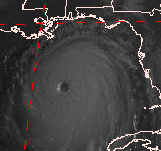 Oh my, Katrina is now a category 5 hurricane. Hopefully she will both weaken a bit and not hit New Orleans.
Oh my, Katrina is now a category 5 hurricane. Hopefully she will both weaken a bit and not hit New Orleans.
New Orleans is like a bowl of chocolate pudding with the city pressing down on it’s skin. You can stand on the street in New Orleans and gaze up and over the levee to watch the huge ships above you..
John McPhee’s most excellent book Control of Nature has a section about all this.
Levees are an beautiful exemplar of public goods. Public goods come in various structures and levees are at one of the extremes. The quality of the levees is defined by the worse section of the leeve. The minimum over the set of all contributions defines the quality. In the early days, during a storm, men would get in a boat and head across the river to break the levees on the other side.
In the last century the Army Core of Engineers has spent vast sums of money keep the Mississippi river flowing past New Orleans. It really badly wants to switch to a different course far to the west.
Later, around noon east coast time
“Mayor Ray Nagin ordered an immediate evacuation Sunday for all of New Orleans … police and firefighters would fan out throughout the city telling residents to get out. … police would have the authority to commander any vehicle or building that could be used for evacuation or shelter … The hurricane’s landfall could still come in Mississippi and affect Alabama and Florida, but it looked likely to come ashore Monday morning on the southeastern Louisiana coast, said Ed Rappaport, deputy director of the National Hurricane Center in Miami. That put New Orleans squarely in the crosshairs.
‘If it came ashore with the intensity it has now and went to the New Orleans area, it would be the strongest we’ve had in recorded history there,” Rappaport said in a telephone interview Sunday morning. “We’re hoping of course there’ll be a slight tapering off at least of the winds, but we can’t plan on that. So whichever area gets hit, this is going to be a once in a lifetime event for them.’… “We’re in for some trouble here no matter what,” he said. (more)
The photo at right is a sheet of plywood driven thru a palm tree by Hurricane Andrew, the last category 5 storm to this the US. More pictures here and here are pictures from Camille another category 5 storm which hit near New Orleans in 1969.
Trip to the Market
 Got to wondering about the cost of that trip to Haymarket. The trip is about 15 miles round trip and I get about 20 miles to the gallon on that drive.
Got to wondering about the cost of that trip to Haymarket. The trip is about 15 miles round trip and I get about 20 miles to the gallon on that drive.
Let’s do this per day. The typical American drives about 30 miles per day. If I’m getting 20 miles per gallon overall then at $2.60/gallon that’s $3.90/day. The insurance is about $1.25/day. The car’s maintenance is about $2.50/day (for example the new tires will cost me $260 over the internet). I estimated the 5$/day depreciation using kbb.com. If capital costs me 5% a year and the car is worth $12K; then the cost of capital is about $1.60 day.
$3.90 -- gas
$5.00 -- depreciation
$2.50 -- maintenance
$1.60 -- cost of capital
$1.25 -- insurance
---------
$12.65 -- Total/day
$.42 -- cost/mile assuming 30 miles/day
The 15 file trip to Haymarket included a dollar for parking so the trip to Haymarket cost about $7.33.
The IRS has 40.5 cents per mile for it’s standard milage rate. While these numbers for new cars are 15 or 25 cents higher.
Taking a cab would have cost about 4-5 times that much. The cost of the bus/subway combo pass is $2.34 per day. One reason I got to thinking about this was that we just shipped my son’s junk off to college and UPS charged a “fuel” surcharge; which let me to wonder what percentage of their costs actually are fuel. Shipping him, i.e. his plane flight, is amazingly cheap. 7.1 cents a mile.
So far I’ve updated this a few times. First because I had the wrong #s for the insurance; particularly because we just dropped my daughter off the insurance. Secondly because I’d forgotten the cost of capital (thanks Martin). Then we decided that the car’s trip computer is very confusing and I had the wrong distance to Haymarket. A few people have argued that my original $1.50/day for maintainance was too low, so I raised that. I originally estimated the depreciation by just playing with the milage; which got about ten cents a mile. I’ve now played with the age of the car and that adds another 7 cents a mile. Mark Denovich provided the autoclub data for new car cost of ownership. 9/13/05: IRS raises the milage rate to 48.5 cents per mile.
And then we have this poor guy.
Escaping the Long Tail – an infectious disease example
Imagine the plight of the poor bacterium. It want’s to be a big player, but it’s just one of a huge number of bacterium and it’s tough climbing up the rankings. First off it needs to get past that huge barrier to entry, the stomach. Very occationally it manages that. But now it discovers that the ecology it’s entered, the intestine, is crowded with vast numbers of natives. These guys aren’t very welcoming. Worst yet they are well adapted to local market conditions. Early adopters I suspect. What to do?
 Cholera’s solution to this problem is to: appeal to the Government, manipulate the platform vendor, trick the host body. It delivers a swift kick to the digestive track wall, via a toxin, and the host body flushes the entire digestive track. This empties out the ecology of all those pesky competitors. The end result is that Cholera’s ranking isn’t so far down the tail anymore.
Cholera’s solution to this problem is to: appeal to the Government, manipulate the platform vendor, trick the host body. It delivers a swift kick to the digestive track wall, via a toxin, and the host body flushes the entire digestive track. This empties out the ecology of all those pesky competitors. The end result is that Cholera’s ranking isn’t so far down the tail anymore.
I wonder if there is an example of this pattern in business. The direct analogy would require a platform vendor who regularly deals with bad actors by flushing out the entire ecology. Sort of like the police clearing out a marketplace when ever fights start breaking out among some of the market participants. Democratic governments with regular elections might be an example. A varient of the classic problem of regulatory capture. Which then reminds me of the phrase “A new broom sweeps clean.”
In point of fact Cholera’s not particularly interested in capturing the host’s regulatory system. The goal is actually to achieve the maxiumum reproduction and then to spread successfully thru it’s distribution vector; i.e. the water supply.
Some of the management cult memes exhibit that pattern. They aren’t particularly focused on enhancing the operations of the firm but instead infect the minds of the employees who then leave carrying the memes to other firms. Their success is then enhanced by triggering the exodus of existing employees.
Emily update
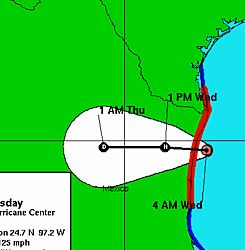
It looks to me like Emily is managing to go ashore just far enough south so the concentrated population along the border will be spared the worst of the wind.
… a strong Category 3 storm … 125 mph … The eye of the storm came ashore just before dawn near San Fernando, a town about 80 miles south of the U.S.-Mexico border. The National Hurricane Center in Miami said hurricane force winds extended outward 70 miles. Tropical storm-force winds blew over south Texas.
I think this side looking radar image (pdf) of the Brownsville-Matamoros area is very cool. You can see how the river has grown more convoluted over time, and also how occationally it folds back on it’s self so that an entire loop is then abandoned. (more maps).
On a more serious note.
expect rains to swamp the low lying ramshackle settlements known as colonias which line the Rio Grande, many of which have no drainage systems…. “It is going to be a very dangerous situation. We could easily see 15 inches of rain in some mountains areas and that will cause flash floods and mudslides,” said Stacy Stewart of the U.S. National Hurricane Center in Miami. …Many fretted over the fate of their modest corrugated iron homes.
(more)
Emily, a Quiz

How many people live just south of the Texas border with Mexico? Which side of a hurricane is more dangerous?
update: A lot of people. In 2000 just Tamaulipas, Mexican state in the north east corner of mexico had 2.75 Million people. The cities along this border have been growing very fast over the last two decades. By way of comparison the New Orlean metropolitian area’s estimated population in 2000 was 1.33 Million.
Hurricanes spin counter clockwise. Where the forward motion and the spin combine creates the most dangerous region. In this example that would be the north side of the storm.
vynol
Wires
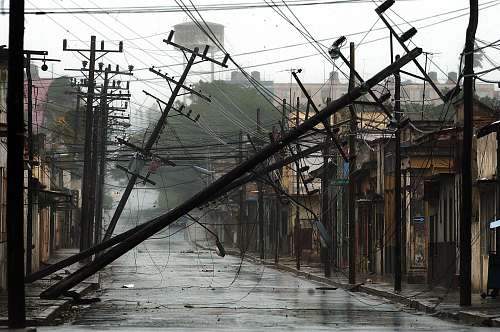
Cienfuegos Cuba, after Hurricane Dennis.
In the 1880’s some of the streets of New York were said to be dark with wires. The great blizzard of 1888 led to moving most of the wiring below ground.
Routing around failure:
” ‘One of the most extraordinary incidents of the great storm was a despatch [sic] received in this city on March 13, from Boston by way of London. For forty-eight hours there had been no telegraphic or railroad communication between New York and Boston. The correspondent of the Boston Globe, who has special wires from Boston running into the World office, has been unable to communicate with his editor. That night the correspondent received a despatch [sic] from him by way of London. The cables both from Boston and New York were in working order.’ — The Blizzard Men of 1888
Sociable Genetics
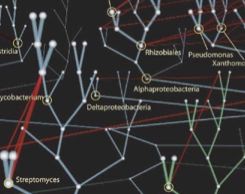 Very cool. Biologists have starting mapping out the routes taken by genes as they move across species. For example how microbes traffic in various tricks of the trade, e.g. resistance to antibiotics. The resulting graphs are social in nature. A highly connected microbe can act as a hub thru which a useful gene is more likely to transit on it’s way to others just the same way that a idea or a infection is more likely to run thru those of us who are more sociable.
Very cool. Biologists have starting mapping out the routes taken by genes as they move across species. For example how microbes traffic in various tricks of the trade, e.g. resistance to antibiotics. The resulting graphs are social in nature. A highly connected microbe can act as a hub thru which a useful gene is more likely to transit on it’s way to others just the same way that a idea or a infection is more likely to run thru those of us who are more sociable.
… a few species are like hubs, with spokes radiating out to the other species. This is the same pattern that turns up in many networks in life, from the genes that interact in a cell to the nodes of the Internet. These hubs can bring a vast number of nodes into close contact. It’s why you can play Six Degrees of Kevin Bacon. In the microbial world, this network allows genes to move quickly through the tree of life, whether those genes provide resistance to antibiotics or allow microbes to cope with some other change in the environment. The Kevin Bacons of the microbial world, at least in the current study, seem to be species that live in habitats where they may come in intimate contact with other species, such as in plant roots. They then act as gene banks from which other species can make withdrawals (…more)
This kind of stuff is too much fun. It lets you think in wild funny metaphors. For example. Consider a proffession (i.e. lawyering, doctoring, management, programming, what have you) and treat it as a species where the practitioners are individuals of the species. Some tricks of a trade are passed down to the practitioner from the coherent pool of knowledge that makes up the trade and this is like the legacy of one’s genes. While some practical knowledge is drawn in latterally thru the social networks that cross broundries. Some proffessions are more like mammals, with strong immune systems that regulate the exchange while others are like bacteria.

